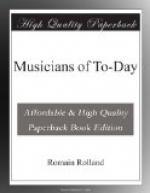And, lastly, I want to speak of the greatest danger of all that menaces music in Germany; there is too much music in Germany. This is not a paradox. There is no worse misfortune for art than a super-abundance of it. The music is drowning the musicians. Festival succeeds festival: the day after the Strasburg festival there was to be a Bach festival at Eisenach; and then, at the end of the week, a Beethoven festival at Bonn. Such a plethora of concerts, theatres, choral societies, and chamber-music societies, absorbs the whole life of the musician. When has he time to be alone to listen to the music that sings within him? This senseless flood of music invades the sanctuaries of his soul, weakens its power, and destroys its sacred solitude and the treasures of its thought.
You must not think that this excess of music existed in the old days in Germany. In the time of the great classic masters, Germany had hardly any institutions for the giving of regular concerts, and choral performances were hardly known. In the Vienna of Mozart and Beethoven there was only a single association that gave concerts, and no Chorvereine at all, and it was the same with other towns in Germany. Does the wonderful spread of musical culture in Germany during the last century correspond with its artistic creation? I do not think so; and one feels the inequality between the two more every day.
Do you remember Goethe’s ballad of Der Zauberlehrling (L’Apprenti Sorcier) which Dukas so cleverly made into music? There, in the absence of his master, an apprentice set working some magic spells, and so opened sluice-gates that no one could shut; and the house was flooded.
This is what Germany has done. She has let loose a flood of music, and is about to be drowned in it.
CLAUDE DEBUSSY
PELLEAS ET MELISANDE
The first performance of Pelleas et Melisande in Paris, on April 30th, 1902, was a very notable event in the history of French music; its importance can only be compared with that of the first performance of Lully’s Cadmus et Hermione, Rameau’s Hippolyte et Aricie, and Quick’s Iphigenie en Aulide; and it may be looked upon as one of the three or four red-letter days in the calendar of our lyric stage.[199]
[Footnote 199: May I be allowed to say that I am trying to write this study from a purely historical point of view, by eliminating all personal feeling—which would be of no value here. As a matter of fact, I am not a Debussyite; my sympathies are with quite another kind of art. But I feel impelled to give homage to a great artist, whose work I am able to judge with some impartiality.]
The success of Pelleas et Melisande is due to many things. Some of them are trivial, such as fashion, which has certainly played its part here as it has in all other successes, though it is a relatively weak part; some of them are more important, and arise from something innate in the spirit of French genius; and there are also moral and aesthetic reasons for its success, and, in the widest sense, purely musical reasons.




